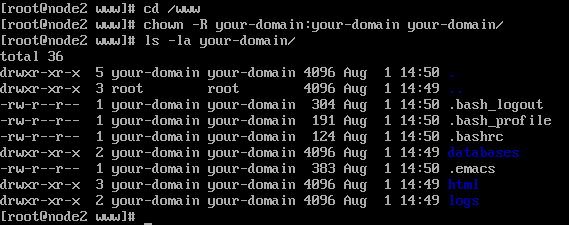1960’s : Interactive use of systems started to gain ground. Not only interactive use, but having several people use the same computer at the same time(noting but multi user), from different terminals. Such systems were called time-sharing systems and were quite a challenge to implement compared to the batch systems.
1965’s : There were many attempts at building good time-sharing systems. Some of these were university research projects, others were commercial ones. One such project was Multics, which was quite innovative at the time. It had, for example, a hierarchical file system, something taken for granted in modern operating systems. This multics was the project of combined effort of Bell Lab’s, MIT,GE. The Multics project did not, however, progress very well. It took years longer to complete the anticipated and never got a significant share of the operating system market. One of the participants, Bell Labs, withdrew from the project. The Bell Labs people who were involved then made their own operating system and called it as Unix.
1969 : First UNIX 1 was released.
1970-1989 : So many flavers of unix came at this time depending on the lack of feature’s in the previous systems up to unix 7 was released in this time.
1990 : By this time, Unix had a strong position in the server market and was especially strong in universities. Most universities had Unix systems and computer science students were exposed to them. Many of them wanted to run Unix on their own computers as well. Unfortunately, by that time, Unix had become commercial and rather expensive. About the only cheap option was Minix, a limited Unix-like system written by Andrew Tanenbaum for teaching purpose. There was also 386BSD, a precursor NetBSD, FreeBSD, and OpenBSD, but that wasn’t mature yet, and required higher end hardware than many had at home.
Into this scene came Linux, in October, 1991. Linus Torvalds, the author, had used Unix at the University of Helsinki, and wanted something similar on his PC at home. Since the commercial alternatives were way too expensive, he started out with Minix, but wanted something better and soon started to write his own operating system. After it’s first release, it soon attracted the attention of several other hackers. While Linux initially was not really useful except as a toy, it soon gathered enough features to be interesting even for people uninterested in operating system development.
first mail from linus to hacker community
From: torvalds@klaava.Helsinki.FI (Linus Benedict Torvalds)
Newsgroups: comp.os.minix
Subject: What would you like to see most in minix?
Summary: small poll for my new operating system
Message-ID: <1991aug25.205708.9541@klaava.helsinki.fi>
Date: 25 Aug 91 20:57:08 GMT
Organization: University of Helsinki
I’m doing a (free) operating system (just a hobby, won’t be big and
professional like gnu) for 386(486) AT clones. This has been brewing
since april, and is starting to get ready.I’d like any feedback on
things people like/dislike in minix, as my OS resembles it somewhat
(same physical layout of the file-system(due to practical reasons)
among another things). I’ve currently ported bash(1.08) and gcc(1.40),and
things seem to work.This implies that I’ll get something practical within a
few months, and I’d like to know what features most people would want. Any
suggestions are welcome, but I won’t promise I’ll implement them 🙂
Linus (torvalds@kruuna.helsinki.fi)
PS. Yes – it’s free of any minix code, and it has a multi-threaded fs.
It is NOT protable (uses 386 task switching etc), and it probably never
will support anything other than AT-harddisks, as that’s
all I have :-(.
Second mail to community:
From: torvalds@klaava.Helsinki.FI (Linus Benedict Torvalds)
Newsgroups: comp.os.minix
Subject: Free minix-like kernel sources for 386-AT
Message-ID: <1991oct5.054106.4647@klaava.helsinki.fi>
Date: 5 Oct 91 05:41:06 GMT
Organization: University of Helsinki
Do you pine for the nice days of minix-1.1, when men were men and wrote their own device drivers?
Are you without a nice project and just dying to cut your teeth on a OS you can try to modify for your
needs? Are you finding it frustrating when everything works on minix? No more all-nighters to get a nifty program working? Then this post might be just for you 🙂
As I mentioned a month(?)ago, I’m working on a free version of a minix-lookalike for AT-386 computers. It has
finally reached the stage where it’s even usable (though may not be depending on
what you want), and I am willing to put out the sources for wider distribution. It is just version 0.02 (+1 (very
small) patch already), but I’ve successfully run bash/gcc/gnu-make/gnu-sed/compress etc under it.
Sources for this pet project of mine can be found at nic.funet.fi (128.214.6.100) in the directory /pub/OS/Linux.
The directory also contains some README-file and a couple of binaries to work under linux
(bash, update and gcc, what more can you ask for :-). Full kernel source is provided, as no minix code has been
used. Library sources are only partially free, so that cannot be distributed currently. The system is able to compile
“as-is” and has been known to work. Heh. Sources to the binaries (bash and gcc) can be found at the
same place in /pub/gnu.
Most of the critically important syste
m software, including the C compiler, came from the Free Software Foundation’s GNU project. Started in 1984, the GNU project aims to develop an entire Unix-like operating system that is completely free. To credit them, many people like to refer to a Linux system as a GNU/Linux system. (GNU has their own kernel as well).
During 1992 and 1993, the Linux kernel gathered all the necessary features it required to work as a replacement for Unix workstations, including TCP/IP networking and a graphical windowing system (the X Window System). Linux also received plenty of industry attention, and several small companies were started to develop and distribute Linux. Dozens of user groups were founded, and the Linux Journal magazine started to appear in early 1994.
| “I still maintain the point that designing a monolithic kernel in 1991 is a fundamental error. Be thankful you are not my student. You would not get a high grade for such a design :-)” (Andrew Tanenbaum to Linus Torvalds) |
| Your job is being a professor and researcher: That’s one hell of a good excuse for some of the brain-damages of minix. (Linus Torvalds to Andrew Tanenbaum) |

A Beaming Linus Today

Linus in 2002
ate. Revered by Computer communities worldwide, Linus is by far the most popular programmer on this planet.
Addtional info related to OS’s:
Different types of unix’s
| 1BSD 2BSD 3BSD 4BSD 4.4BSD Lite 1 4.4BSD Lite 2 386 BSD Acorn RISC iX Acorn RISC Unix AIX AIX PS/2 AIX/370 AIX/6000 AIX/ESA AIX/RT AMiX AOS Lite AOS Reno ArchBSD ASV Atari Unix A/UX BOS BRL Unix BSD Net/1 BSD Net/2 BSD/386 BSD/OS CB Unix Chorus Chorus/MiX Coherent CTIX CXOs Darwin Debian GNU/Hurd DEC OSF/1 ACP DesktopBSD | Digital Unix DragonFly BSD Dynix Dynix/ptx ekkoBSD Eunice FireFly BSD FreeBSD FreeDarwin GNU GNU-Darwin Gnuppix GNU/Hurd-L4 HPBSD HP-UX HP-UX BLS IBM AOS IBM IX/370 Interactive 386/ix Interactive IS IRIS GL2 IRIX Linux Lites LSX Mac OS X Mac OS X Server Mach MERT MicroBSD Mini Unix Minix Minix-VMD MIPS OS RISC/os MirBSD Mk Linux Monterey more/BSD mt Xinu | MVS/ESA OpenEdition NetBSD NeXTSTEP NonStop-UX Open Desktop Open UNIX OpenBSD OpenDarwin OpenServer OpenSolaris OPENSTEP OS/390 OpenEdition OS/390 Unix OSF/1 PC-BSD PC/IX Plan 9 Plurix PWB PWB/UNIX QNX QNX RTOS QNX/Neutrino QUNIX ReliantUnix Rhapsody RISC iX RT SCO UNIX SCO UnixWare SCO Xenix SCO Xenix System V/386 Security-Enhanced Linux Silver OS Sinix Sinix ReliantUnix Solaris SPIX | SunOS Triance OS Tru64 Unix Trusted IRIX/B Trusted Solaris Trusted Xenix TS Tunis UCLA Locus UCLA Secure Unix Ultrix Ultrix 32M Ultrix-11 Unicos Unicos/mk Unicos/mp Unicox-max UNICS UniSoft UniPlus UNIX 32V UNIX Interactive UNIX System III UNIX System IV UNIX System V UNIX System V Release 2 UNIX System V Release 3 UNIX System V Release 4 UNIX System V/286 UNIX System V/386 UNIX Time-Sharing System UnixWare UNSW USG Venix Xenix OS Xinu xMach z/OS Unix System Services |
| ABCenix ACIX AD Altos System V ARIX AurOS BOS/X C Executive CLIX Consensys Unix Concentrix ConvexOS CPIX Cromix CX/UX DC/OSx Dell Unix | DG/UX DISTRIX DNIX DomainOS DRM System DTIX DVIX ENIX EP/IX Esix SVR4 Eurix FOR:PRO FreeMiNT FTX Genix HCR Helios | HEP-UPX HI-UX IDRIS INOS LSX LynxOS MachTen MacMach MAXION/OS MCS Micronix Microport SVR4 MicroPort Unix Mimos MMOS MP-RAS UNIX MST UNIX | Mulplix Munix NachOS NCR Unix NDIX News-OS NUXI Oasis ONIX OPUS OS 9 OS/MP OSx PCUNIX PNX QNIX Regulus | RT/EMT RTUX SORIX SOX Sphinx SPP-UX Stellix SUNIX Super-UX System B Thix TI System V TNIX Topix TOS Tropix UHC Unix | Umax Uniq Unisis Unity UNOS UTEK UTS UTX/32S UX UXP/DS UZIX VM/IX VOLVIX Xoftnix Zeus |
Brian Kernighan
http://cm.bell-labs.com/cm/cs/who/bwk/index.html
Dennis Ritchie
http://cm.bell-labs.com/cm/cs/who/dmr/index.html
Ken Thompson
http://plan9.bell-labs.com/who/ken/
The above three are responsable for unix first version.
Different types of Linux’s
Linus Torvalds
http://www.cs.helsinki.fi/u/torvalds/
And last but not least see the link below
http://www.catb.org/~esr/faqs/linus/
Q & A
1. When is first UNIX introduced?
Ans : 1969.
2. What is the present version of RedHat Enterprice Linux (by april 2007)?
Ans : RHEL5.
3. What is the present version of linux kernel (by april 2007)?
Ans : Precent version of linux kernel is 2.6.20.7.
4. What is the kernel type used bye linux?
Ans : Modular kernel (i will explain this in comming class ie in 133 classes).
5. State some Unix flavers you know?
Ans : Free BSD, NetBSD, OpenBSD, HP Unix(from HP), Solaries (from Sun micro systems).
6. State some Linux flavers you know?
Ans : RHEL, Fedora, CentOS, Ubuntu, Lindows(which have features of linux and MS window’s), Suse, Debain etc.
7. What is the main difference between fedora and RHEl?
Ans : a.RedHat will give support to only for RHEL but not for Fedora with some charge.
Ans : a. RedHat Desktop
b. RedHat Enterprice server
c. RedHat Advanced Server
d.RedHat work station.
a. unix is monolithic kernel where as linux uses modular kernel.
b. some commands will differ
c. unix is commersial where as linux is free
d. linux support different hardware you can install linux on notebook too.
Ans : The given below link is enough
http://www.michaelhorowitz.com/Linux.vs.Windows.html




